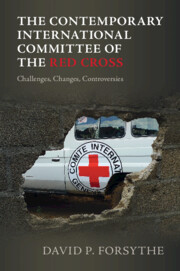Book contents
- The Contemporary International Committee of the Red Cross
- The Contemporary International Committee of the Red Cross
- Copyright page
- Dedication
- Contents
- Photographs
- Preface: Who and Why
- 1 The Contemporary ICRC and Its Critics
- 2 The ICRC and the Global Humanitarian System
- 3 History
- 4 History
- 5 The Red Cross Movement
- 6 The Red Cross Movement
- 7 ICRC Relations with Bern
- 8 ICRC Relations with Bern
- 9 Humanitarians and Business
- 10 Humanitarians and Business
- 11 Interpreting the Mandate
- 12 Interpreting the Mandate
- 13 Has the Traditional Focus Been Lost?
- 14 Has the Traditional Focus Been Lost?
- 15 ICRC Governance and Management
- 16 ICRC Governance and Management
- 17 Conclusion
- 18 Conclusion
- Epilogue
- Annex
- Index
6 - The Red Cross Movement
Part II – Seville and Syria
Published online by Cambridge University Press: 01 February 2024
- The Contemporary International Committee of the Red Cross
- The Contemporary International Committee of the Red Cross
- Copyright page
- Dedication
- Contents
- Photographs
- Preface: Who and Why
- 1 The Contemporary ICRC and Its Critics
- 2 The ICRC and the Global Humanitarian System
- 3 History
- 4 History
- 5 The Red Cross Movement
- 6 The Red Cross Movement
- 7 ICRC Relations with Bern
- 8 ICRC Relations with Bern
- 9 Humanitarians and Business
- 10 Humanitarians and Business
- 11 Interpreting the Mandate
- 12 Interpreting the Mandate
- 13 Has the Traditional Focus Been Lost?
- 14 Has the Traditional Focus Been Lost?
- 15 ICRC Governance and Management
- 16 ICRC Governance and Management
- 17 Conclusion
- 18 Conclusion
- Epilogue
- Annex
- Index
Summary
This chapter focuses on a contemporary Movement agreement summarized as Sevilla 2.0. This 2022 agreement tries to specify a division of labor along with increased cooperation within the Movement, both longstanding concerns. Sevilla 2.0 reflects a semantic emphasis on local humanitarian actors, with much rhetoric about the importance of National RC Societies. The agreement shows a certain fatigue with establishment and Western-based (and Western-funded) organizations such as the ICRC. However, in Sevilla 2.0 the ICRC was able to protect its traditional roles and functions, while agreeing to be more of a team player. How the ICRC and its partners functioned in the Syrian armed conflict of 2011–2022 is then examined. This case shows a very complicated relationship between the ICRC and the Syrian Arab Red Crescent Society, on the one hand, and, on the other hand, between these two actors and various fighting parties, chief among which was the Assad government. The ICRC was compelled to abandon a fully Dunantist posture in the Syrian complex conflict. Comparisons are made with other organizations and conflicts.
Keywords
- Type
- Chapter
- Information
- The Contemporary International Committee of the Red CrossChallenges, Changes, Controversies, pp. 114 - 132Publisher: Cambridge University PressPrint publication year: 2024

